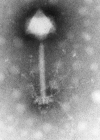The third age of phage
- PMID: 15884981
- PMCID: PMC1110918
- DOI: 10.1371/journal.pbio.0030182
The third age of phage
Abstract
The third age of phage has begun with the recognition that phages may be key to the great planetary biogeochemical cycles and represent the greatest potential genetic resource in the biosphere.
Figures
References
-
- Wilhelm SW, Suttle CA. Viruses and nutrient cycles in the sea-Viruses play critical roles in the structure and function of aquatic food webs. Bioscience. 1999;49:781–788.
-
- Bergh O, Borsheim KY, Bratbak G, Heldal M. High abundance of viruses found in aquatic environments. Nature. 1989;340:467–468. - PubMed
-
- Breitbart M, Miyake JH, Rohwer F. Global distribution of nearly identical phage-encoded DNA sequences. FEMS Microbiol Lett. 2004;236:249–256. - PubMed
MeSH terms
LinkOut - more resources
Full Text Sources



